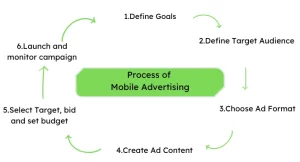What is Mobile Advertising & How does it Work?
Mobile Advertising has become important step to promote your business and ideas to people on large scale.
Source states that 66.6 percent of the global population use a mobile device. More than 80% of internet users use smartphones. And roughly 51% of all web traffic is mobile. 61% of website visitors won’t return to a website that isn’t mobile friendly.
The stats about usage of mobile explains how popular the gadget has become for people. It enables businesses to reach mobile users in specific locations. Statista reports that smartphone subscription globally is currently over 6 billion and it is projected to grow to 7.6 billion by 2027.
Let us get into exploring what mobile marketing is?
What is mobile advertising?
Mobile marketing uses mobile devices like smartphones and tablets to promote products or services to consumers. This can include text messages, in-app ads, and search, display, and video ads.

Mobile marketing is essential because more and more people use their mobile devices for shopping, browsing the internet, and other tasks. Businesses can reach consumers where they spend most of their time with mobile marketing.
Effective mobile marketing campaigns use location-based targeting, personalization, and push notifications. This helps businesses create targeted and engaging campaigns that drive traffic, increase sales, and build brand awareness.
Mobile app ads-What is it?
Mobile app ads refer to advertisements specifically designed and optimised for mobile applications.
- Mobile app ads are shown inside mobile apps to promote products, services, or other apps.
- Mobile app ads can be banner ads, interstitial ads, native ads, video ads, or rewarded ads, depending on the ad format and placement in the app.
- Mobile app ads aim to capture users’ attention, generate awareness, drive engagement, and encourage desired actions such as app installs, in-app purchases, or user interactions.
- They leverage mobile capabilities, such as precise targeting, location-based targeting, and interactive elements, to deliver relevant and compelling ad experiences.
- Advertisers often use mobile app ads to reach their target audience efficiently, as mobile devices have become essential to people’s lives.
- Mobile app ads enable businesses to tap into the ecosystem, connect with potential customers, and drive app downloads or conversions.
- Mobile app ads are a crucial part of mobile marketing strategies, helping businesses achieve their goals and maximize their reach in the mobile app landscape.
Steps in mobile advertising
The steps involved in mobile advertising can vary depending on the specific strategy and tactics used but generally include the following:

- Define goals and target audience: Before starting any mobile advertising campaign, defining the goals and target audience is essential. This will help create compelling ads that resonate with the audience and drive desired outcomes.
- Pick an ad format: Mobile ads come in different forms, like banner ads, interstitial ads, native ads, and video ads. Choose the design that best fits your campaign goals and target audience’s preferences.
- Create ad content: Once you’ve picked a format, it’s time to create your ad. Ensure it’s visually appealing, concise, and relevant to your target audience. And optimize it for mobile devices.
- Select targeting options: Mobile advertising allows targeting options such as demographics, interests, behaviour, and location. Advertisers can select the targeting options that best align with the goals and target audience of the campaign.
- Set up bidding and budget: Mobile advertising involves bidding systems where advertisers compete for ad space. Advertisers can set a budget and bidding strategy to ensure the ad is displayed to the target audience within the budget.
- Launch and monitor the campaign: Once the ad is created and the movement is set up, it’s time to launch it. Advertisers should closely monitor the campaign’s performance and adjust as needed to optimise results.
- Measure and analyse results: After the campaign has ended, measuring and analysing the results is essential. This will help determine the campaign’s effectiveness and identify areas for improvement in future campaigns.
Mobile advertising: different ways
Mobile advertising shows ads on mobile devices like smartphones and tablets. These ads can be banner ads, video ads, and more. Mobile advertising aims to reach a specific audience and encourage them to take action, such as clicking on the ad, downloading an app, or making a purchase.
Mobile advertising can be done in different ways:
- Mobile web ads appear on mobile websites or within mobile apps while browsing the internet.
- In-app ads: These ads appear within mobile apps and can be banner ads, video ads, or native ads.
- Location-based ads: These ads use your mobile device’s location data to show ads relevant to your location.
- SMS or MMS ads: These ads are sent to mobile users as text or multimedia messages.
Mobile advertising relies heavily on targeting capabilities to reach the right audience. Advertisers can target mobile users based on demographics, interests, behaviour, and location.
By leveraging these targeting capabilities, advertisers can create highly personalised and relevant ads that resonate with their audience and drive desired outcomes.
Mobile advertising also involves bidding systems where advertisers compete for ad space. Advertisers bid on keywords or audience segments, and the highest bidder’s ad is displayed to the targeted user. The cost of mobile advertising varies depending on the ad format, targeting options, and bidding system used.
Read: A beginner’s guide to performance marketing
Things to keep in mind for mobile advertising
When it comes to mobile advertising, there are several things that advertisers should keep in mind to ensure the success of their campaigns. Some of the key considerations include:
- Mobile optimisation: Mobile ads should be optimised for smaller screens and slower load times of mobile devices. Advertisers should ensure their ads are mobile-friendly and load quickly to avoid frustrating users and potentially losing their attention.
- Relevance and personalisation: Mobile users expect relevant and personalised ads to their interests and needs. Advertisers should target their ads to the right people who are most likely to be interested in what they offer. Ads should also be relevant to the content that the user is viewing.
- User experience: Mobile ads should be smooth and engaging. They should be exciting, informative, and seamlessly fit into the user’s experience.
- Call to action: Mobile ads should tell the user what you want them to do, whether clicking on the ad, downloading an app, or making a purchase.
- Measurement: Advertisers should track how well their ads are performing to improve their campaigns over time.
- Compliance: Mobile ads must follow all applicable laws and regulations. They should not be misleading or deceptive and should respect the user’s privacy.
Conclusion
Mobile advertising is a powerful way to reach and engage with people on their phones and tablets. To be successful, advertisers need to create relevant and personalized ads that won’t annoy users. They also need to track their results and follow the rules. If you are willing to kick-start with mobile advertising connect with us.
FAQ
Is Mobile Advertising Different from Desktop Advertising?
Yes, mobile advertising is distinct from desktop advertising. Mobile ads are designed specifically for smaller screens and often leverage features like touch interaction and location-based targeting. Desktop ads, on the other hand, are tailored for larger screens and different user behaviours.
How Can Mobile Advertising Benefit Local Businesses?
Mobile advertising can significantly benefit local businesses by allowing them to target potential customers in their immediate vicinity. With location-based targeting, these businesses can promote special offers or events to nearby mobile users, driving foot traffic and boosting sales.
What are in app ads?
In-app ads are paid advertisements that appear within mobile apps. They can take various forms, such as banners, video, and interactive ads. In-app ads are a way for app developers to monetize their apps and for advertisers to reach a large and engaged audience.



